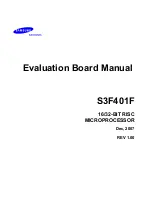
TMC262-EVAL MANUAL (V. 1.0 / 2011-Sep-07)
10
Copyright © 2010 TRINAMIC Motion Control GmbH & Co. KG
figure 4: Evaluation software: Starting the motor
6.1.4
Clock frequency setting
You can modify the TMC262 clock frequency delivered from the CPU to the TMC262. As also the SPI
and Step signal input synchronization are affected by this setting, we advise working with 16MHz or
with the internal clock frequency (Jumper setting for internal or external CLK should be done before
board power up). Default is 16MHz.
6.1.5
Using stallGuard2™ and coolStep™
In order to use the stallGuard2
™ functionality and coolStep™, you should first tune the stallGuard2™
sensitivity.
As a first step, you should enable the stallGuard™ filter bit SFILT in the tab SGCSCONF.
figure 5: Evaluation software: coolStep setting
Therefore, operate the motor at a reasonable velocity (taking into account your application) and look at
the stallGuard™ value (SG) in the DRVSTATUS tab or watch the stallGuard value in the Graph tab.
Now, apply slowly increasing mechanical load to the motor. If the motor stalls before the stallGuard™
value reaches zero, go to the SGSCONF tab and decrease the stallGuard threshold value (SGT). A
good starting value is zero. You can apply negative values and positive values. If the values leave a
range o/-10, probably your velocity setting is too high or too low. If the SG value reaches zero
far before the motor stalls, increase the SGT value.
The optimum setting is reached, when the stallGuard2
™ value reaches zero at increasing load shortly
before the motor stalls due to overload.
Now, you are ready to enable coolStep™! Go to the SMARTEN tab and set SEMAX and SEMIN to a
value different from 0. This enables coolStep. A good value for both is 1 or 2 for most motors. Now,
coolStep is enabled and you should see the current scale SE decreasing when the motor does not see
any load (see tab Graph). You can modify current increase and current reduction speed by changing
SEUP and SEDN. You can select, if the current becomes scaled down to ½ of CS or to ¼ of CS, using
SEIMIN setting.
For details and sample traces, please see the TMC262 data sheet.































